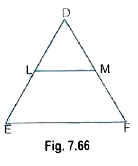E and F are points on the sides PQ and PR respectively of ΔPQR. For each of the following cases, state whether EF || QR:
(i) PE = 3.9 cm. EQ = 3 cm. PF = 3.6 cm and FR = 2.4
(ii) PE = 4 cm. QE = 4.5 cm. PF = S cm and RF = 9 cm
(iii) PQ = 1.28 cm, PR = 2.56 cm, PE = 0.18 cm and PF = 0.36 cm
To determine whether the line segment EF is parallel to QR in each case, we can use the Basic Proportionality Theorem (also known as Thales' theorem). According to this theorem, if a line is drawn parallel to one side of a triangle, it divides the other two sides proportionally.
The theorem states that if EF || QR, then:
PEEQ=PFFR
We will check this for each case provided.
Case (i):
Given:
- PE = 3.9 cm
- EQ = 3 cm
- PF = 3.6 cm
- FR = 2.4 cm
Step 1: Calculate the ratios.
1. Calculate PEEQ:
PEEQ=3.93=1.3
2. Calculate PFFR:
PFFR=3.62.4=1.5
Step 2: Compare the ratios.
Since 1.3≠1.5, we conclude that EF is not parallel to QR.
Conclusion for Case (i):
EF is not parallel to QR.
---
Case (ii):
Given:
- PE = 4 cm
- EQ = 4.5 cm
- PF = 5 cm
- RF = 9 cm
Step 1: Calculate the ratios.
1. Calculate PEEQ:
PEEQ=44.5=89
2. Calculate PFRF:
PFRF=59
Step 2: Compare the ratios.
Since 89≠59, we conclude that EF is not parallel to QR.
Conclusion for Case (ii):
EF is not parallel to QR.
---
Case (iii):
Given:
- PQ = 1.28 cm
- PR = 2.56 cm
- PE = 0.18 cm
- PF = 0.36 cm
Step 1: Calculate the ratios.
1. Calculate PEPQ:
PEPQ=0.181.28
2. Calculate PFPR:
PFPR=0.362.56
Step 2: Simplify the ratios.
1. For 0.181.28:
0.18×1001.28×100=18128=964
2. For 0.362.56:
0.36×1002.56×100=36256=964
Step 3: Compare the ratios.
Since 964=964, we conclude that EF is parallel to QR.
Conclusion for Case (iii):
EF is parallel to QR.
---
Summary of Results:
- Case (i): EF is not parallel to QR.
- Case (ii): EF is not parallel to QR.
- Case (iii): EF is parallel to QR.
Given:
- PE = 3.9 cm
- EQ = 3 cm
- PF = 3.6 cm
- FR = 2.4 cm
PEEQ=3.93=1.3
PFFR=3.62.4=1.5
EF is not parallel to QR.
Given:
- PE = 4 cm
- EQ = 4.5 cm
- PF = 5 cm
- RF = 9 cm
PEEQ=44.5=89
PFRF=59
EF is not parallel to QR.
Given:
- PQ = 1.28 cm
- PR = 2.56 cm
- PE = 0.18 cm
- PF = 0.36 cm
PEPQ=0.181.28
PFPR=0.362.56
0.18×1001.28×100=18128=964
0.36×1002.56×100=36256=964
EF is parallel to QR.
- Case (i): EF is not parallel to QR.
- Case (ii): EF is not parallel to QR.
- Case (iii): EF is parallel to QR.
Similar Questions
Points E and F respectively lie on sides PQ and PR of ΔPQR. For condition given below state whether EF∣∣QR
PE = 3.9 cm, EQ = 3 cm, PF = 3.6 cm and FR = 2.4 cm
View SolutionD and E are points on the sides AB and AC respectively of ΔABC. In each of the following cases, determine whetheer DE∣∣BC or not. (i) AD=5.7cm,DB=9.5cm,Ae=4.8cmandEC=8cm. (ii) AB=11.7cm,AC=11.2cm,AD=6.5cmandAE=41.2cm, (iii) AB=10.8cm,AD=6.3cm,AC=9.6cmandEC=4cm. (iv) AD=7.2cmAE=6.4cm.AB=12cmandAC=10cm.
View Solution
Knowledge Check
In △PQR L and M are two points on the sides PQ and PR respectively such that LMII QR. If PL = 2cm, LQ = 6 cm and PM= 1.5 cm, then MR (in cm) is
A0.5B4.5C9D8
M and N are points on the sides AC and BC respectively of a ΔABC. In ech of the fopllowing cases, state whether MN∣∣AB.
(i) CM=4.2cm.MA=2.8cm,NB=3.6cm,5.7
(ii) CB=6.92cm,CN=1.04cm,Ca=1.73cm,CM=0.26cm
(iii) CM=5.1cm,CA=6.8cm,CB=5.6cm,NB=1.4cm.
View SolutionPoints E and F respectively lie on sides PQ and PR of ΔPQR. For condition given below state whether EF∣∣QR
PE = 4 cm, QE = 4.5 cm, PF = 8 cm and RF = 9 cm
View SolutionE and F are points on the sides PQ and PR respectively of a ΔPQR. Show that Ef||QR. If PQ = 1.28 cm,PR= 2.56 cm,PE = 0.18 cm and PF= 0.36 cm.
View SolutionPE=4m,QE=4.5m,PF=8mandRF=9m.
Is EF∣∣QR? Justify your answer.

View SolutionR and s are points on the sides DE and EF respectively of a ΔDEF such that ER = 5 cm , RD = 2.5 cm , SE = 1.5 cm and FS = 3.5 cm .Find whether RS||DF or not .
View SolutionL and M are points on the sides DE and DF respectively of a MJEF. State whether LM II EF or not.
DE = 8 cm, DF = 15 cm, LE = 3.2 cm and MF= 6 cm.

View SolutionM and N are points on sides AC and BC respectively of a △ABC. State whether MN||BC if CM = 4.2 cm, MA= 2.8 cm , NB = 3.6 cm, CN = 5.7 cm.
View Solution
